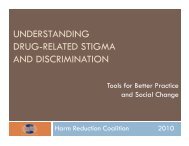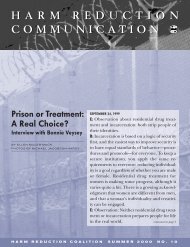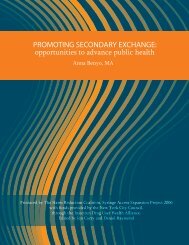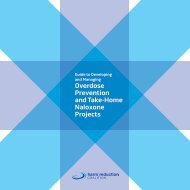9th - Harm Reduction Coalition
9th - Harm Reduction Coalition
9th - Harm Reduction Coalition
Create successful ePaper yourself
Turn your PDF publications into a flip-book with our unique Google optimized e-Paper software.
<strong>9th</strong><br />
National <strong>Harm</strong> <strong>Reduction</strong> Conference<br />
FROM PUBLIC HEALTH TO SOCIAL JUSTICE<br />
the passage of New York’s innovative 911 Good Samaritan law – the only state law that offers protection from arrest as well<br />
as prosecution – advocates created a public education campaign to inform the public about the law. This presentation will<br />
discuss what we learned from the process of getting buy-in from government agencies, as well as the potential opportunities<br />
the 911 Good Samaritan laws present to educate the public about overdose prevention policy in general. What are the<br />
best strategies to demonstrate to people that calling 911 will not lead to arrest and prosecution How can public education<br />
campaigns also educate government agencies Can 911 laws be used to educate people about other aspects of overdose<br />
prevention, or is it best not to “muddy the message”<br />
Benefit Maximization<br />
Since many drugs, such as psychedelics and marijuana, have proven therapeutic and medicinal uses, a harm reduction<br />
strategy not only seeks to reduce the harms that drugs can cause, but also to maximize their potential benefits. People<br />
who use psychedelics sometimes have challenging emotional experiences that can become dangerous when they lead to<br />
counterproductive medical interventions or contact with law enforcement. In response, some harm reduction services aim<br />
to empower people who use psychedelics and their peers with techniques for assisting others through difficult experiences<br />
and, in doing so, to provide a new framework for looking at “bad trips” as opportunities for psychological growth. What are<br />
the policy implications of psychedelic harm reduction services And how might the scientific research community, policy<br />
advocates, and harm reduction practitioners work together to improve and expand existing theoretical models and on-theground<br />
practices<br />
Jag Davies is the publications manager for the Drug Policy Alliance, where he directs the content and production of the organization’s<br />
reports, advocacy materials, and organizational literature. Davies previously served as policy researcher for the ACLU Drug<br />
Law Reform Project. He also previously served as director of communications for MAPS, a nonprofit pharmaceutical company<br />
conducting FDA clinical trials aimed at developing psychedelics and marijuana into prescription medicines.<br />
Davis, Alan, Bowling Green State University, Bowling Green, Ohio<br />
akdavis@bgsu.edu<br />
Acceptance of Non-Abstinence by Clinicians<br />
Previous research has found relatively limited acceptance of non-abstinence goals in addiction treatment settings in the<br />
United States. Because such attitudes may have changed over time, this study was designed to assess the current acceptance<br />
of non-abstinence goals by addiction professionals as a function of type of substance (alcohol vs. drug), severity of<br />
the disorder (DSM-IV abuse vs. dependence) and finality of the outcome goal (intermediate vs. final). The sample comprised<br />
913 members of a national association of addiction professionals who completed a web-based survey. Over one-half of respondents<br />
rated non-abstinence as somewhat or completely acceptable as both an intermediate and final outcome goal for<br />
clients with alcohol abuse, but considerably smaller proportions rated non-abstinence an acceptable intermediate or final<br />
outcome goal for clients with alcohol dependence. Regarding drug-taking clients, one-half and one-third of respondents<br />
rated non-abstinence somewhat or completely acceptable as an intermediate goal and final outcome goal, respectively,<br />
for clients with drug abuse, but fewer rated non-abstinence an acceptable outcome goal for clients with drug dependence.<br />
Although acceptance varied by substance, diagnosis and finality of outcome goal, supporting clients who want to pursue<br />
non-abstinence holds promise to: a) attract and retain in treatment those who reject or are ambivalent about abstinence,<br />
b) provide a respite from excessive, unhealthy consumption to improve the health and wellbeing of addicted clients, and c)<br />
reduce the harmful impacts of excessive consumption on the larger, non-substance abusing or dependent population.<br />
Confidence to Reduce Alcohol Use and Related <strong>Harm</strong><br />
To reduce both excessive consumption of alcohol and its consequences, people may employ protective behavioral strategies<br />
intended to reduce the amount of alcohol they consume and to slow the speed of their drinking. However, studies have found<br />
that young adults use these forms of harm reduction inconsistently. The present study had two aims: 1) Combine research<br />
with a harm reduction intervention by distributing T-shirts, printed with six drinking-reduction strategies, as compensa-<br />
28











